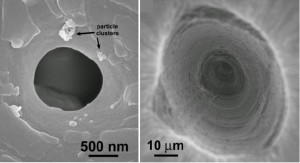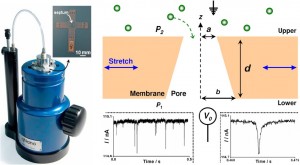I was introduced to nanofluidics though collaborations with the MacDiarmid Institute (one of NZ’s Centres of Research Excellence) and Izon Science. Izon is a Christchurch-based manufacturer of the qNano and qMicro, which use elastomeric pores for ‘tunable resistive pulse sensing’ of micro- and nanoparticles suspended in solution. These devices can measure the concentration [1], size [2] and even surface charge [3] of such particles.
Tunable Resistive Pulse Sensing and Nanofluidic Transport
Figure (from [1]): SEM imaging of conical pores used for tunable resistive pulse sensing. Left, the smaller entrance and right, the larger entrance showing the bore of the pore. The clustered particles near the small pore were used in sensing experiments prior to imaging.
Tunable resistive pulse sensing (TRPS) has emerged as an important technique for sensing and analysing particles dispersed in aqueous electrolytes. In TRPS, an electric field is applied across a single pore in a thin membrane, and the current carried by ions moving through the pore is measured. When a particle (e.g. an emulsion drop or a magnetic bead) passes through the pore, the ionic current is momentarily blocked and a ‘resistive pulse’ is observed. Pulses reveal information about the particles. Izon Science manufactures instrumentation and software for TRPS.
The technique is now being applied in a growing range of interesting studies in bionanotechnology, involving (for example) viruses and bacteria, on-bead tethering, aggregation assays, liposomes and exosomes (see Izon’s publications page and media releases). Some of our recent work includes studies of aptamer-based sensors (with Gil Lee (UCD) and Mark Platt (Loughborough)) [4], magnetic nanoparticles [5], and emulsions (with Victoria University and the Riddet Institute) [6]. We also work on enhancement of surface charge measurements, analysis of deformable particles, and co-ordination of TRPS with fluorescence spectroscopy.
Figure (from [6]): Left, Izon’s qNano apparatus. Tunable pores are located in the central septum of a polyurethane membrane (inset), which is placed within a fluid cell on top of the instrument. Controlled pressure is applied across the membrane using a tube sealed into the upper fluid cell. Right, a schematic cross-section of the pore itself, with geometric variables labelled. Also shown are experimental data for several emulsion droplet resistive pulses (inset, lower left), and one typical pulse in greater detail (inset, lower right).
Understanding nanofludic transport is a theme common to most TRPS studies. Fluids and particles are driven through and around nanoscale structures by a range of tranport mechanisms, including pressure, electrophoresis, electro-osmosis, dielectriphoresis, Brownian motion – and even magnetism, in the case of superparamagnetic beads. We have studied nanofluidic tansport in order to understand TRPS, and we hope to extend this work to similarly interesting nanoscale configurations.
The Dynamics of Slippery Particles
Slip plays an important and controversial part in nanofluidic transport. Non-zero slip occurs when the fluid immediately adjacent to a solid surface is moving relative to that surface. Slip is not significant for normal (Newtonian) liquids at reasonably large length scales. Slip has been measured, however, around nanofluidic structures, especially when the solid surface is hydrophobic – that is, it chemically repels water. These measurements are difficult and sensitive, with the slip ‘length’ usually less than 100 nm.
We are interested in establishing a consistent understanding and theory for slip across different experimental systems. The usual theoretical approach suggests that slip should alter both action and reaction forces at an interface, so that free-standing asymmetric bodies such as Janus particles would experience a torque ([7,8], see Figure). So far, the most sensitive measurements of slip have monitored fixed solid surfaces rather than free-standing bodies.
Figure (from [7]): Spheres with a slip boundary condition in uniform flow. Arrows show the calculated first-order correction to the usual flow field due to slip. Slip is indicated by dark shading on the spheres, so that the boundary conditions are (left) full coverage with slip, (middle) asymmetric with continuous variation, and (right) asymmetric with discontinuous variationan – ideal Janus particle. Corresponding torque is indicated by εT(1) in the aysmmetric cases.
Slip could be useful for increasing, manipulating or understanding flows in microfluidics and nanofluidics, for porous and colloidal systems, and in electrokinetic transport. For practical purposes, it is important to understand the ‘effective’ slip near superhydrophobic surfaces, which occurs on a much larger scales (micrometers) than slip at flat surfaces (tens of nanometers).
References:
[1] Willmott, G. R., Vogel, R., Yu, S. S. C., Groenewegen, L. G., Roberts, G. S., Kozak, D., Anderson, W. and Trau, M. “Use of Tunable Nanopore Blockade Rates to Investigate Colloidal Dispersions,” J. Phys.: Condens. Matter 22, 454116 (2010).
[2] Vogel, R., Willmott, G. R., Roberts, G. S., Anderson, W., Kozak, D., Groenewegen, L., Glossop, B., Barnett, A., Turner, A. and Trau, M., “Quantitative Sizing of Nano/Microparticles with a Tunable Elastomeric Pore Sensor,” Anal. Chem. 83, 3499–3506 (2011).
[3] Vogel, R., Anderson, W., Eldridge, J. E., Glossop, B. and Willmott, G. R., “A Variable Pressure Method for Characterising Nanoparticle Surface Charge using Pore Sensors,” Anal. Chem. 84, 3125-3132 (2012).
[4] Platt, M., Willmott, G. R. and Lee, G. U., “Resistive Pulse Sensing of Analyte-Induced Multicomponent Rod Aggregation using Tunable Pores,” Small 8, 2436-2444 (2012).
[5] Willmott, G. R., Platt, M. and Lee, G. U., “Resistive Pulse Sensing of Magnetic Beads and Supraparticle Structures using Tunable Pores,” Biomicrofluidics 6, 014103 (2012).
[6] Somerville, J. A., Willmott, G. R., Eldridge, J., Griffiths M. and McGrath, K. M., “Size and Charge Characterization of a Submicrometre Oil-in-Water Emulsion using Resistive Pulse Sensing with Tunable Pores,” J. Coll. Interf. Sci. 394, 243-251 (2013).
[7] Willmott, G. R., “Slip-Induced Dynamics of Patterned and Janus-like Spheres in Laminar Flows,” Phys. Rev. E 79, 066309 (2009).
[8] Willmott, G. R., “Dynamics of a Sphere with Inhomogeneous Slip Boundary Conditions in Stokes Flow,” Phys. Rev. E 77, 055302(R) (2008).


